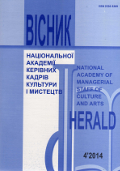ІМПЛОЗІЯ КУЛЬТУРИ У СИМУЛЯТИВНИХ ВИМІРАХ ПОСТМОДЕРНУ
Implosion of culture in the simulation measures of postmodern
Author(s): Olga SukhinaSubject(s): Anthropology, Visual Arts, Semiology, Aesthetics, Communication studies, Structuralism and Post-Structuralism
Published by: Національна академія керівних кадрів культури і мистецтв
Keywords: implosion of culture; postmodern; simulacrum; neomythologisation; screen culture;
Summary/Abstract: In the article the phenomenon of cultural implosion in the simulative measures of postmodern is explored. This phenomenon appears in the conditions of intensive perception of fictious nature of the sign space which had lost the reality and it bears now the impression of the total simulation that has become a general perception of the world in the modern era. Regarding this fact the necessity of research of the reasons and cultural simulative mechanism has become an important demand. Nevertheless, the theoreticians of postmodern such as G. Deleuze, J. Baudrillard, G. Bataille, J. Derrida, J.-L. Nancy, M. McLuhan, J.Lacan, M. Blanchot, J.-F. Lyotrad, J.Kristeva have been studied this phenomenon, and the problem of simulation remains in the culture of postmodern a question of an urgent importance.The term "implosion" is translated from English as "vybuh" and it is directed inside. We can find the culturological reception of the implosion in the works of M. McLuhan, J.Lacan, G. Deleuze, J. Baudrillard, J. Derrida, J.-L. Nancy, M. Merleau-Ponty, and also N. Mankovska, O. Degtiarova, S. Grofa, K. Raslogova, B. Boruhova, O. Chulkov, V. Bosenko etc. They have extended the ethymological meaning of the phenomenon "implosion", creating its explicative field that remains the basis for discussion. The implosion is presented in the works of M. McLuhan and J. Baudrillard as a non-classical type of aesthetic perception that has appeared as a result of transmission of cultural symbols by means of mass media artifacts. According to surveillance of M. McLuhan the electronic means of communication, which are able to deliver the information with speed of lightening, creates the effect of the explosive compression of not only information itself but also of space and time. It is notable that M. McLuhan appeals to L.Kerroll who has a new perception of space and time of the electronic era. The concept of L.Kerroll has become the basis of G. Deleuzes’ philosophy. G. Deleuze had read in the works of L.Kerroll about terrible "battle of depth" in which the things are totally broken and these things explode us from the inside. G. Deleuze appealed in the work "Marsel Proust and signs" to the art as to the highest form of being, he considered it as a space which contains all times and all forms. This is a space of imaginations and dreams, hallucinogenic visions where time is not only slackening the rhythm, but also changes the vector of its direction.Postmodern art pays attention not by chance on the changed states of consciousness, drugs and psychodelic cultures. G. Deleuzes’ concept of time plurality is outlited in the works of Serbian writer M.Pavych. G. Deleuze explored the cooperation of actual and virtual things on the example of the mirror palace from the movie "Lady from Shanghai" by Orson Uells. It is important that the verges of crystal are distorting mirrors which divide the image into two parts, and it stays in the constant pursuit for itself. Being as a symbol of other existence the mirror shows its range and makes the cooperation and interpenetration possible in the world. The mirror images are the bearers of plural meanings. The researches of M.Bakhtin, S.Kierkegaard, J.Lakan, M. Merleau-Ponty, V. Foucault are concentrated on the perception issue of mirror image. The metaphor of mirror actualizes the culturological discourse of O. Degtiarova who analyses the phenomenon of "mirror imperative" and also historical and philosophical researches of B.Boruhov, O.Chulkov, A.Losev. Implosivness is typical for mirrors, they absorb everything what can be reflected. Therefore, the things and people are the objects of one level and according to it, everything is served for absorbtion.The culture of postmodern, using different mystifications, confabulated the mirror cover, transforming it into phenomenon of screen. That is why, nowadays, the term screen culture is ingrained in the culturology, and that means a complex of characters, created by the law of myth. It offers a new system of cultural coordinates in which the accepted reality is constructed and the adapting of new proposals of informative society had been taken place. As a result the personal ranges are vanished and the spiritual orientations are defined by the range of screen.According to K. Razlogov, the effect of reality of audiovisual character becomes a tool for global adulteration because new forms of screen communication simulate our psychological processes, breaking into our world and making influence on mental structures. J. Baudrillard had spoken about implosive violence which emerged on the global structure of goals demolition and stipulated by excessive social compression. According to J. Baudrillard the implosion can stipulate bad consequences as revolution because of simulation, the agonized reality blocks up the postreality that offers survival among broken pieces of culture.Thus, the recipient of the modern culture gets into aesthetic and cultural trap of implosion that develops the strategy of substitution, imitation, simulation. The implosion transforms unrecognazibly the usual social connections, en-suring the triumph of the sign culture. It is a special type of world perception that affirms neomythologisation of the world by the means of screen culture. As a result the substitution of the reality had taken place by the virtual simulacrum.The results of the research give deeper understanding of implosion, encourage creation of the appropriate reflexive space for overcoming of the modern social and cultural crisis. It is important to speak about an urgent demand of life-asserting creative work in order to preserve personal identity and self-realization in the space of national culture.
Journal: Вісник Національної академії керівних кадрів культури і мистецтв
- Issue Year: 2014
- Issue No: 4
- Page Range: 63-68
- Page Count: 6
- Language: Ukrainian

